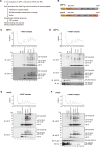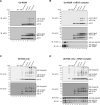A distinct mammalian disome collision interface harbors K63-linked polyubiquitination of uS10 to trigger hRQT-mediated subunit dissociation
- PMID: 36302773
- PMCID: PMC9613687
- DOI: 10.1038/s41467-022-34097-9
A distinct mammalian disome collision interface harbors K63-linked polyubiquitination of uS10 to trigger hRQT-mediated subunit dissociation
Abstract
Translational stalling events that result in ribosome collisions induce Ribosome-associated Quality Control (RQC) in order to degrade potentially toxic truncated nascent proteins. For RQC induction, the collided ribosomes are first marked by the Hel2/ZNF598 E3 ubiquitin ligase to recruit the RQT complex for subunit dissociation. In yeast, uS10 is polyubiquitinated by Hel2, whereas eS10 is preferentially monoubiquitinated by ZNF598 in human cells for an unknown reason. Here, we characterize the ubiquitination activity of ZNF598 and its importance for human RQT-mediated subunit dissociation using the endogenous XBP1u and poly(A) translation stallers. Cryo-EM analysis of a human collided disome reveals a distinct composite interface, with substantial differences to yeast collided disomes. Biochemical analysis of collided ribosomes shows that ZNF598 forms K63-linked polyubiquitin chains on uS10, which are decisive for mammalian RQC initiation. The human RQT (hRQT) complex composed only of ASCC3, ASCC2 and TRIP4 dissociates collided ribosomes dependent on the ATPase activity of ASCC3 and the ubiquitin-binding capacity of ASCC2. The hRQT-mediated subunit dissociation requires the K63-linked polyubiquitination of uS10, while monoubiquitination of eS10 or uS10 is not sufficient. Therefore, we conclude that ZNF598 functionally marks collided mammalian ribosomes by K63-linked polyubiquitination of uS10 for the trimeric hRQT complex-mediated subunit dissociation.
© 2022. The Author(s).
Conflict of interest statement
The authors declare no competing interests.
Figures






References
Publication types
MeSH terms
Substances
LinkOut - more resources
Full Text Sources
Molecular Biology Databases
Research Materials

